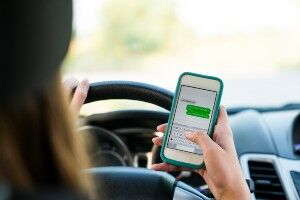 Distracted driving accidents can cause serious injuries and are among the leading causes of traffic fatalities. If you have been injured in a crash, the other driver may have been texting or otherwise distracted. You may be eligible to pursue compensation to help cover your medical expenses and loss of income.
Distracted driving accidents can cause serious injuries and are among the leading causes of traffic fatalities. If you have been injured in a crash, the other driver may have been texting or otherwise distracted. You may be eligible to pursue compensation to help cover your medical expenses and loss of income.
But how do you go about proving the other driver was not paying attention at the time of the crash? This can be a difficult task without legal representation. An experienced lawyer will know what to look for when conducting his or her own investigation into what happened.
Below, we discuss several ways to prove driver distraction. Our legal team at Greg Monforton & Partners is ready to collect the supportive evidence needed to build a strong case on your behalf. An initial consultation comes with no cost, risk or obligation to you. There are also no upfront fees to get started.
Supportive Evidence of Distracted Driving
A single piece of evidence is usually not enough to prove the crash was caused by a distracted driver. Multiple forms of evidence that you and your lawyer can use to support your claim includes:
Police Report Filed
The responding officer at the scene may have notes referencing distracted driving in the official police report. Some compelling evidence that could be provided include:
- The officer’s own observations that suggest or implicate distracted driving
- The at-fault driver’s statement to the officer, admitting he or she was distracted
- Statements from other motorists, passengers, pedestrians or bystanders
- What the officer uncovered in the other driver’s cellphone
Crash Scene Photos and Video
Photos and video taken at the time of the crash may help show the other driver was inattentive while behind the wheel. A photo of the roadway without any skid marks or tire tracks could suggest that the other driver failed to hit the brakes because he or she was distracted. Photos of property damage could capture the extent of damage and suggest that the other driver failed to swerve and caused the crash.
A distracted driver may also be caught on camera. Video footage from cellphones, traffic cameras or security surveillance from nearby businesses may show the other driver was not focused on the road.
Witness Testimony
Another way to help prove a driver was distracted is through eyewitness testimony. Witnesses could include your passengers, the other driver’s passengers, people in other vehicles and pedestrians. They may have seen the other driver texting, eating or drinking, reaching for an item or engaging in some other sort of distraction. Statements from credible witnesses can play an important role in your claim.
Cellphone Records
If the other driver was talking on the phone and/or sending text messages at the time of the crash, your lawyer may be able subpoena his or her cellphone records. These records will show the exact time and date of the activity. A police officer may sometimes inspect a driver’s phone at the scene or even confiscate it as evidence, which may provide additional details needed to establish driver distraction.
Vehicle Data
A lot of newer vehicles have advanced computer equipment that monitors and tracks a driver’s activity behind the wheel. There could be a digital record of how fast the vehicle was traveling or whether the driver was changing the radio or actively using other electronic controls when the crash occurred.
Social Media Activity
Other evidence that leaves behind an electronic trail is having a social media presence. If the other driver was sharing or posting on social media, that activity might be logged and timestamped online.
Your lawyer may decide to hire an expert to uncover electronic evidence of distracted driving, such as him or her uploading a photo or video on a social media platform or posting or commenting on a message to help strengthen your claim for compensation.
Distracted Driving Laws in Ontario
Distracted driving is a serious issue in the province, causing more traffic fatalities than speeding and drunk driving. Ontario defines distracted driving as any activity that takes a driver’s attention away from the road. It is illegal to use a cellphone or any other hand-held wireless communication device to text or dial and view display screens or program a GPS system, even if stopped at a red light.
Drivers are allowed to use hands-free wireless communication devices with an earpiece or Bluetooth. Drivers can also view GPS display screens if they are built in or securely mounted on the dashboard.
The fines for distracted driving can range from $615 for first-time offenders to $3,000 for third-time offenders. This will also result in three to six demerit points added to a driver’s record.
If the other driver was eating, drinking, smoking, reading or reaching for items at the time of the crash, this is not considered part of Ontario’s distracted driving law. However, he or she could still be charged with careless or dangerous driving.
Speak with a Qualified Lawyer Today
If you have been injured in a crash and suspected distracted driving is to blame, reach out to a qualified car accident lawyer in Windsor today. Our firm has represented many accident victims over the past four decades, recovering millions of dollars on behalf of our clients.
Let us discuss your potential legal options during a risk-free, no-obligation consultation. It costs nothing up front after this initial meeting to have us represent you. We only get paid if you get compensated.
Find out if you have a case. Ph: (866) 320-4770